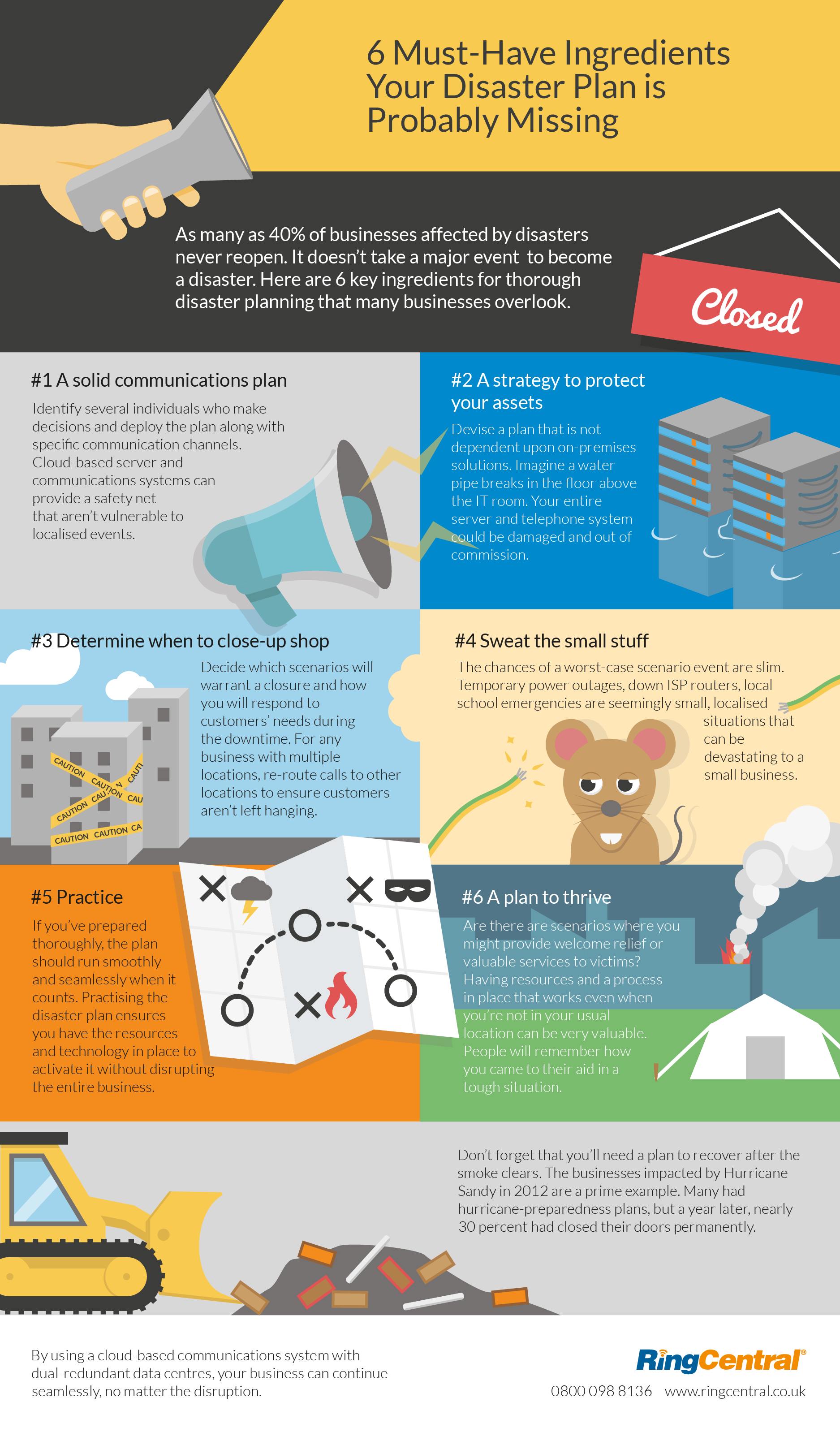
When most companies think of their “disaster plan,” these are the typical elements that come to mind and the things you may need to weather a severe storm, power outage or other temporary interruption to business as usual. But, now that you’ve covered the obvious basics, what about the things that aren’t things at all? What about the intangible processes, policies and systems that are crucial for ensuring continuity and survival of the business, especially in the wake of a prolonged event?
Unfortunately, far too many businesses are unprepared, despite having ample supplies of flashlights, batteries and bottled water. FEMA estimates that as many as 40 percent of businesses affected by disasters never reopen. While extensive property damage may be the culprit in many cases, lack of proper planning for intangibles is also often at fault.
And, let’s not forget that a disaster doesn’t just mean a major catastrophe or a huge nationwide event like 7/7. What constitutes a disaster varies greatly from one location or one business to another. A closure on the motorway leading to your restaurant can be a disaster if tonight’s entrée ingredients are on a truck that’s stuck in gridlocked traffic. Or, worse yet, what if a crazed gunman takes hostages on the corner of your street resulting in an hours-long standoff with police? How will your employees and customers get to and from your business?
Having a disaster plan that goes beyond essential supplies and covers a wide range of scenarios is critical. Here are six key ingredients for thorough disaster planning that many business overlook:
2) A strategy to protect your assets. So many vital business tools are dependent upon reliable utility service. For example, the security of your building, employees and data would all be compromised in the event of a simple power outage. Or, let’s say a water pipe breaks in the floor above the IT room. Your entire on-premises server and/or telephone system could be damaged and out of commission. To protect your assets, devise a plan that is not dependent upon on-premises solutions. Cloud services can help here by providing a reliable, survivable off-site solution to data access and security and communications continuity.
3) A formula to determine when to carry on or close-up shop. In certain situations, deciding whether to remain open is a no-brainer. In a widespread weather disaster, immediate local terrorist situation or other extraordinary circumstances, temporary closure is the only prudent option. That is, unless you can relocate operations to another site. Decide which scenarios will warrant a closure and how you will respond to customers’ needs during the downtime. For a call center or any business with multiple locations, re-route calls to other locations to ensure customers aren’t left hanging.
4) A plan to thrive. I’d certainly never suggest that any business take advantage of disaster victims. However, there are scenarios in which a business with a plan to thrive can provide welcome relief or valuable services to victims. For example, maybe your restaurant has been affected by a community-wide blackout, but you still have good access to ingredients supplies, along with chefs and other staff who are willing to do what’s needed to help your neighbors. Setting up a mobile site in another facility can provide much-needed meals to residents who would otherwise struggle to feed their families under the circumstances. Or, if you’re an insurance company, you absolutely cannot be down when your customers need you the most. While many send in a mobile response unit manned by auxiliary staff that still means your local agents—those individuals your customers have come to know and trust—are unavailable when they need them most. Having resources and a process in place that works even when you’re not in your usual location can be very valuable. People will remember how you came to their aid in a tough situation.
5) Sweat the small stuff. Most companies plan for the worst; hurricanes, blizzards, tornadoes or other massive events. And, while that’s important, the chances of a worst-case scenario event are slim. Instead, it’s the little things that can spell disasterl; a temporary power outage, a major ISP router goes down, or a local school emergency means all of your employees must leave immediately to pick up their children. Those types of seemingly small, localised, situations can be devastating to a small businesses. Having a plan of action for these short-term molehills can keep them from turning into insurmountable mountains.
6) Practice. If the first time you activate the disaster plan is during an actual emergency, good luck. Just like the fire drills you probably remember from elementary school, it takes practice to know what to do, especially in a stressful situation. Practicing the disaster plan also requires that you have the resources and technology in place to activate it on the fly without disrupting the entire business. After all, if you’ve planned properly and thoroughly, the plan should run smoothly and seamlessly both in practice and when it counts.
When planning for a disaster, ironically, most businesses forget that they’ll need a plan to recover after the smoke clears. They plan for immediate response for scenarios in which there’s no recovery, and overlook long-term survivability. The businesses impacted by in the U.S by Hurricane Sandy’s brutal landfall on the East Coast in 2012 are a prime example: while many likely had hurricane-preparedness plans, a year later, nearly 30 percent had closed their doors permanently.
While devastating property damage was a major factor for New York and New Jersey business owners, what about smaller, isolated incidents, like the winter storms that devastated the Devon and Cornwall coast in 2014? Or, the chaos that ensued in the wake of the London riots of 2011?
The fact is it doesn’t take a major event to become a bona fide disaster for your business. The key is to be prepared for a wide range of scenarios, have a plan for recovery and survivability in the aftermath and practice, practice, practice.
Does your business have a reliable disaster recovery plan in place?
Originally published Nov 04, 2015, updated Apr 18, 2021



